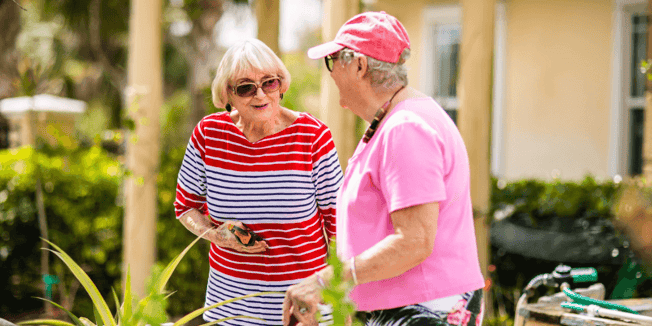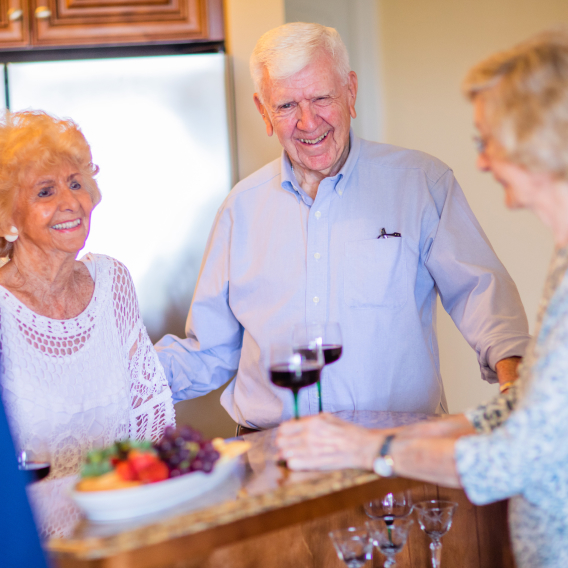What Does Companionship Mean in Senior Living Communities?

Humans are social by nature. We all want a connection with others, and a support network of friends can make us feel less lonely. Getting together with friends gives a boost to the week and something to look forward to.
As we age, our social circles get smaller for various reasons and isolation may increase. For example, when someone retires, they may lose contact with coworkers they were close to at their job; their close friends may move away over time; or they may not be able to safely drive anymore, limiting their ability to visit others. Generally, this means more coordination of travel is necessary as friends and family make the effort to see their loved ones.
Social isolation has a number of negative effects including depression, anxiety, stroke, heart disease, cognitive decline, and an increased risk of dementia. These health effects are especially concerning for seniors because they can lead to safety risks for those still living at home. During the COVID-19 pandemic, quarantine and the loss of socialization opportunities brought to light exactly how important a sense of community and connection to others is.
Fortunately, there are ways to combat isolation and increase companionship. One strategy is a move to a senior living community, an environment that is designed to increase connection. Let’s take a deeper look at the significance of companionship in general and in senior living communities.
The Importance of Companionship
Approximately one-fourth of adults aged 65 and older are socially isolated. Ensuring that seniors have plenty of social opportunities is integral to a positive, healthy aging experience.
Companionship prevents isolation. It’s a feeling of friendship cultivated by spending time with people you care about, and a companion is a person who frequently associates with someone and accompanies them to places. Companionship is significant for seniors, whether they are in a senior living community or not, because it goes a long way toward alleviating loneliness and social isolation.
Why Does Social Isolation Happen?
Considering how important socialization is, why does it decline as we age? Although some adults would rather retire and stay home alone reading books, that’s the exception rather than the rule. Social isolation is generally not a choice, and numerous factors can lead to it.
At a certain point, family and friends may start moving away, especially when aging friends are moving away to be closer to their own children or grandchildren. Additionally, a social circle may shrink as friends pass away.
Most geographical areas are not entirely walkable, requiring a car to get places. In a more isolated living environment, after a senior has stopped driving, getting out of the family house can be difficult, whether it’s to visit others or go to the store. It’s essential for friends and family members who still live nearby to make the effort to visit. Knowing someone is coming to visit has numerous benefits, including keeping the brain active, providing companionship, and having a designated time each week to look forward to.
How Can I Tell if a Loved One Is Isolated?
Although social isolation can be hard to spot, a few warning signs are more obvious than others, including:
- Loss of interest in socialization
- Loss of interest in hobbies
- Lack of motivation
- Memory problems
- Neglecting personal hygiene and care
Some isolation indicators, such as memory problems, are also a symptom of dementia. How can you spot the difference? With social isolation, your loved one may be aware of ongoing memory problems, whereas with dementia, they wouldn’t notice their own forgetfulness. Dementia is often accompanied by other problems such as slow mental decline and impairment in motor, writing, or speaking skills.
Is it time to get help for you or your loved one? Take our 4-minute assessment to get more detail on the right direction for you.
Take the AssessmentThe Benefits of Companionship
Companionship doesn’t just lower the possibility of negative health outcomes—it also creates positive outcomes.
Social Skill Maintenance
The brain needs activity and stimulation, and without stimulation, the brain tends to decline. By regularly interacting with others, you’re using mental effort and empathy to navigate through social situations such as asking for help, pointing out a mistake, or asking about someone’s day. Finding regular strategies to engage can prevent these social skills from declining.
Health-Related Improvement
Companionship promotes better mental health by providing opportunities for the brain to be active. Cognitive decline is a risk of social isolation, so when socialization increases, it not only reduces the risk of dementia but also keeps the brain stronger and more resilient. This helps people continue to learn new things as they age.
Companionship can also promote better physical health. The act of doing physical things makes the body stronger, even if exercise isn’t the intent. For example, going to dinner with a family member means getting ready at home, walking to and from the car, and navigating inside the restaurant. Additionally, having a friend or family member as regular company for a walk or a swim can help motivate someone to stick to a light exercise regimen.
New Patterns in the Week
Companionship makes seniors feel supported and cared for. Not only that, but companionship also helps seniors engage as active members of society. Maintaining socialization routines creates healthier patterns in the week. Instead of each day being monotonous, the person’s social calendar is filled with events and responsibilities. The more events a person has on their social calendar, the more likely it is that basic personal hygiene and house cleanliness habits are maintained.
Ensuring Safety
An isolated adult may not receive the necessary care if something goes wrong—for instance, a physical accident or medical emergency. One solution is the companionship found in a senior living community, which resolves some of the "what ifs" of living alone. Whether a senior is living at home or in a community, maintaining scheduled engagements with others can ensure they’re being checked on regularly. If they aren’t where they’re supposed to be or if something else is wrong, someone is more likely to notice.
Is it time to get help for you or your loved one? Take our 4-minute assessment to get more detail on the right direction for you.
Take the AssessmentThe Advantages of Companionship in Senior Living Communities
Senior living communities provide a sense of belonging and present more daily companionship opportunities than someone might find alone in a house. These communities are designed with connectedness in mind, and the team members who work there ensure that opportunities for social interaction are part of each day.
Senior living provides plenty of shared social spaces. Depending on the community, these might include movie theaters, hobby rooms, and exercise areas to encourage natural socialization between those with like interests. For example, residents who love the outdoors can connect while exploring the gardens and pathways around the community.
Additionally, community dining spaces provide plenty of opportunities for residents to simply sit down and have a conversation over a meal. Residents can also make a new friend at a planned community social event such as a concert, yoga session, or other activities that the social team puts together.
Senior living communities such as Cedarhurst provide additional opportunities for socialization for new incoming residents. For example, there are welcome programs for new residents, and Cedarhurst team members encourage socialization by connecting residents with similar interests.
Start Connecting at Cedarhurst Senior Living Community
There are plenty of opportunities for companionship in senior living communities. Is it time to help your loved one with socialization and companionship? Learn more strategies for overcoming senior isolation in our guide The Power of Connection for Senior Health.






.png?width=307&height=200&name=Blog%20%2333%201400%20x%20700%20(1).png)

.png?width=307&height=200&name=Blog%20%2332%201400%20x%20700%20(8).png)



